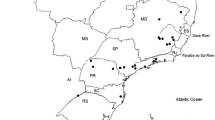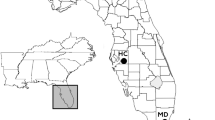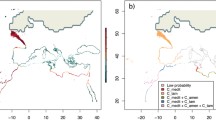Abstract
Atlantic forest is a biome of high diversity that is increasingly under threat from habitat clearance. This habitat contains a large number of endemic species, many of which are currently endangered. Here, we consider the genetic population structure of a Brazilian endemic bird restricted to Atlantic forest, the Brazilian tanager, Ramphocelus bresilius. While currently not threatened, this narrow range endemic faces future habitat reductions, potentially serving as a model species for other birds reliant on this biome. We sampled six populations, three on the mainland (Rio de Janeiro state), and three on a neighbouring continental island (Ilha Grande), to compare the genetic diversity and population structure in these two regions. Using microsatellite data from eight loci generated for 177 individuals, we found that the short ocean crossing significantly restricted gene flow (20–150 km between populations, FCT = 0.057 P < 0.001). Structure analyses, partial Mantel tests and AMOVA all demonstrated a significant split into two groups separated by the ocean. This result was unexpected as the ocean barrier was only 2 km. While island populations were isolated from the mainland, their levels of genetic diversity were similar (AR 4.04 vs 4.59). This represents the first genetic study of an Atlantic forest species, contrasting mainland and populations from the island reserve, Ilha Grande. Similar levels of genetic diversity support the importance of this reserve in the conservation of Atlantic forest species, however the potentially limited exchange by bird species should be taken into account in future conservation planning.




Similar content being viewed by others
References
Abdelkrim J, Hunt GR, Gray RD, Gemmell NJ (2012) Population genetic structure and colonisation history of the tool-using New Caledonian crow. PLoS One 7:e36608
Aleixo A, Galetti M (1997) The conservation of the avifauna in a lowland Atlantic forest in south-east Brazil. Bird Conserv Int 7:235–261
Alho CJR, Schneider M, Vasconcelos LA (2002) Degree of threat to the biological diversity in the Ilha Grande State Park (RJ) and guidelines for conservation. Braz J Biol 62:375–385
Alves MAS, Vecchi MB (2009) Birds, Ilha Grande, state of Rio de Janeiro, Southeastern Brazil. Check List 5:300–313
Belkhir K, Borsa P, Chikhi L, Raufaste N, Bonhomme F (2001) Genetix, logiciel sous WindowsTM pour la génétique des populations. Laboratoire Génome, Populations, Interactions, CNRS UPR 9060, Université de Montpellier II, Montpellier
Bensch S, Price T, Kohn J (1997) Isolation and characterization of microsatellite loci in a Phylloscopus warbler. Mol Ecol 6:91–92
Blackmore CJ, Peakall R, Heinsohn R (2011) The absence of sex-biased dispersal in the cooperatively breeding grey-crowned babbler. J Anim Ecol 80:69–78
Bouzat JL, Johnson K (2004) Genetic structure among closely spaced leks in a peripheral population of lesser prairie-chickens. Mol Ecol 13:499–505
Brawn JD, Collins TM, Medina M, Bermingham E (1996) Associations between physical isolation and geographical variation within three species of neotropical birds. Mol Ecol 5:33–46
Brown LM, Ramey RR, Tamburini B, Gavin TA (2004) Population structure and mitochondrial DNA variation in sedentary Neotropical birds isolated by forest fragmentation. Conserv Genet 5:743–757
Bruford MW, Wayne RK (1993) Microsatellites and their application to population genetic studies. Curr Opin Genet Dev 3:939–943
Buchanan GM, Donald PF, Butchart SHM (2011) Identifying priority areas for conservation: a global assessment for forest-dependent birds. Plos One 6(12):e29080
Burns KJ, Racicot RA (2009) Molecular phylogenetics of a clade of lowland tanagers: implications for avian participation in the great American interchange. Auk 126:635–648
Callens T, Galbusera P, Matthysen E, Durand EY, Githiru M, Huyghe JR, Lens L (2011) Genetic signature of population fragmentation varies with mobility in seven bird species of a fragmented Kenyan cloud forest. Mol Ecol 20:1829–1844
Capparella AP (1988) Genetic variation in neotropical birds: implications for the speciation process. In: Ouellet H (ed) Acta XIX Congressus Internationalis Ornithologici. University of Ottawa Press, Ottawa, pp 1658–1664
Carrascal LM, Cayuela L, Palomino D, Seoane J (2012) What species-specific traits make a bird a better surrogate of native species richness? A test with insular avifauna. Biol Conserv 152:204–211
Castiglioni GDA (1998) Biologia reprodutiva e organização social de Ramphocelus bresilius (Passeriformes:Emberizidae) na restinga de barra de Maricá, Estado do Rio de Janeiro. Universidade Estadual de Campinas, São Paulo
Coelho EP, Alves VS, Fernandez FAS, Soneghet MLL (1991) On the bird faunas of coastal islands of Rio de Janeiro state, Brazil. Ararajuba 2:31–40
Crochet PA (2000) Genetic structure of avian populations—allozymes revisited. Mol Ecol 9:1463–1469
Dawson DA, Hanotte O, Greig C, Stewart IRK, Burke T (2000) Polymorphic microsatellites in the blue tit Parus caeruleus and their cross-species utility in 20 songbird families. Mol Ecol 9:1941–1944
Diamond JM (1975) Assembly of species communities. In: Cody ML, Diamond JM (eds) Ecology and evolution of communities. Belknap Press, Cambridge, pp 342–444
Diamond JM, Gilpin ME, Mayr E (1976) Species-distance relation for birds of the Solomon Archipelago, and the paradox of the great speciators. Proc Natl Acad Sci USA 73:2160–2164
Double MC, Dawson D, Burke T, Cockburn A (1997) Finding the fathers in the least faithful bird: a microsatellite-based genotyping system for the superb fairy-wren Malurus cyaneus. Mol Ecol 6:691–693
Earl DA, vonHoldt BM (2011) STRUCTURE HARVESTER: a website and program for visualizing STRUCTURE output and implementing the Evanno method. Conserv Genet Resour 4:359–361
Evanno G, Regnaut S, Goudet J (2005) Detecting the number of clusters of individuals using the software STRUCTURE: a simulation study. Mol Ecol 14:2611–2620
Excoffier L, Smouse PE, Quattro JM (1992) Analysis of molecular variance inferred from metric distances among DNA haplotypes: application to human mitochondrial DNA restriction data. Genetics 131:479–491
Falush D, Stephens M, Pritchard JK (2003) Inference of population structure using multilocus genotype data: linked loci and correlated allele frequencies. Genetics 164:1567–1587
Frankham R (1997) Do island populations have less genetic variation than mainland populations? Heredity 78:311–327
Frankham R (1998) Inbreeding and extinction: island populations. Conserv Biol 12:665–675
Galbusera P, Githiru M, Lens L, Matthysen E (2004) Genetic equilibrium despite habitat fragmentation in an Afrotropical bird. Mol Ecol 13:1409–1421
Gama SVG, Silva LGAE, Salgado CM (2009) Geologia, Relevo e Solos. In: Bastos M, Callado CH (eds) O ambiente da Ilha Grande. UERJ/CEADS, Rio de Janeiro, pp 21–59
Gilbert KJ, Andrew RL, Bock DG, Franklin MT, Kane NC, Moore J, Moyers BT, Renaut S, Rennison DJ, Veen T, Vines TH (2012) Recommendations for utilizing and reporting population genetic analyses: the reproducibility of genetic clustering using the program STRUCTURE. Mol Ecol 21:4925–4930
Glen AS, Atkinson R, Campbell KJ, Hagen E, Holmes ND, Keitt BS, Parkes JP, Saunders A, Sawyer J, Torres H (2013) Eradicating multiple invasive species on inhabited islands: the next big step in island restoration? Biol Invasions 15:2589–2603
Goudet J (2001) FSTAT, a program to estimate and test gene diversities and fixation indices. http://www.unil.ch/izea/softwares/fstat.html. Accessed 2 Sept 2013
Grant BR (1998) Patterns on islands and microevolution. In: Grant BR (ed) Evolution on islands. Oxford University Press, New York, pp 1–17
Grant PR, Grant BR (1992) Demography and the genetically effective size of two populations of Darwin’s finches. Ecology 73:766–784
Griffith SC, Dawson DA, Jensen H, Ockendon N, Greig C, Neumann K, Burke T (2007) Fourteen polymorphic microsatellite loci characterized in the house sparrow Passer domesticus (Passeridae, Aves). Mol Ecol Notes 7:333–336
Hackett SJ (1996) Molecular phylogenetics and biogeography of tanagers in the genus Ramphocelus (Aves). Mol Phylogenet Evol 5:368–382
Hanotte O, Zanon C, Pugh A, Greig C, Dixon A, Burke T (1994) Isolation and characterization of microsatellite loci in a passerine bird: the reed bunting Emberiza schoeniclus. Mol Ecol 3:529–530
Hoeck PEA, Bollmer JL, Parker PG, Keller LF (2010) Differentiation with drift: a spatio-temporal genetic analysis of Galapagos mockingbird populations (Mimus spp.). Philos Trans R Soc B 365:1127–1138
Hughes AL (2010) Reduced microsatellite heterozygosity in island endemics supports the role of long-term effective population size in avian microsatellite diversity. Genetica 138:1271–1276
INEA (2010) Plano de manejo (fase 2). Parque Estadual da Ilha Grande—Peig. Instituto Estadual do Ambiente (INEA), Rio de Janeiro
Isler ML, Isler PR (1987) The tanagers: natural history, distribution, and identification. Smithsonian Institution Press, Washington
IUCN (2013) The IUCN red list of threatened species. http://www.iucnredlist.org/search. Accessed 14 April 2014
Jakobsson M, Rosenberg NA (2007) CLUMPP: a cluster matching and permutation program for dealing with label switching and multimodality in analysis of population structure. Bioinformatics 23:1801–1806
Jenkins NC, Alves MAS, Pimm SL (2010) Avian conservation priorities in a top-ranked biodiversity hotspot. Biol Conserv 143:992–998
Jensen JL, Bohonak AJ, Kelley ST (2005) Isolation by distance, web service. BMC Genet 6:13
Kalinowski ST (2004) Counting alleles with rarefaction: private alleles and hierarchical sampling designs. Conserv Genet 5:539–543
Kalinowski ST (2005) HP-RARE 1.0: a computer program for performing rarefaction on measures of allelic richness. Mol Ecol Notes 5:187–189
Kekkonen J, Seppa P, Hanski IK, Jensen H, Vaisanen RA, Brommer JE (2011) Low genetic differentiation in a sedentary bird: house sparrow population genetics in a contiguous landscape. Heredity 106:183–190
Keller LF, Jeffery KJ, Arcese P, Beaumont MA, Hochachka WM, Smith JNM, Bruford MW (2001) Immigration and the ephemerality of a natural population bottleneck: evidence from molecular markers. Proc R Soc B 268:1387–1394
Kier G, Kreft H, Lee TM, Jetz W, Ibisch PL, Nowicki C, Mutke J, Barthlott W (2009) A global assessment of endemism and species richness across island and mainland regions. Proc Natl Acad Sci USA 106:9322–9327
Lessa ICM, Bergallo HG (2012) Modelling the population control of the domestic cat: an example from an island in Brazil. Braz J Biol 72:445–452
Lira PK, Tambosi LR, Ewers RM, Metzger JP (2012) Land-use and land-cover change in Atlantic Forest landscapes. For Ecol Manag 278:80–89
Lohman DJ, Ingram KK, Prawiradilaga DM, Winker K, Sheldon FH, Moyle RG, Ng PKL, Ong PS, Wang LK, Braile TM, Astuti D, Meier R (2010) Cryptic genetic diversity in “widespread” Southeast Asian bird species suggests that Philippine avian endemism is gravely underestimated. Biol Conserv 143:1885–1890
Maiorano L, Amori G, Capula M, Falcucci A, Masi M, Montemaggiori A, Pottier J, Psomas A, Rondinini C, Russo D, Zimmermann NE, Boitani L, Guisan A (2013) Threats from climate change to terrestrial vertebrate hotspots in Europe. PLoS One 8:e74989
Manne LL, Brooks TM, Pimm SL (1999) Relative risk of extinction of passerine birds on continents and islands. Nature 399:258–261
Marini MA, Garcia FI (2005) Bird conservation in Brazil. Conserv Biol 19:665–671
Meirmans PG, Hedrick PW (2011) Assessing population structure: F(ST) and related measures. Mol Ecol Resour 11:5–18
Meirmans PG, Van Tienderen PH (2004) GENOTYPE and GENODIVE: two programs for the analysis of genetic diversity of asexual organisms. Mol Ecol Notes 4:792–794
Mila B, Warren BH, Heeb P, Thebaud C (2010) The geographic scale of diversification on islands: genetic and morphological divergence at a very small spatial scale in the Mascarene grey white-eye (Aves: Zosterops borbonicus). BMC Evol Biol 10:158
Moore RP, Robinson WD, Lovette IJ, Robinson TR (2008) Experimental evidence for extreme dispersal limitation in tropical forest birds. Ecol Lett 11:960–968
Myers N, Mittermeier RA, Mittermeier CG, da Fonseca GAB, Kent J (2000) Biodiversity hotspots for conservation priorities. Nature 403:853–858
Nei M (1978) Estimation of average heterozygosity and genetic distance from a small number of individuals. Genetics 89:583–590
Nicholls JA, Double MC, Rowell DM, Magrath RD (2000) The evolution of cooperative and pair breeding in thornbills Acanthiza (Pardalotidae). J Avian Biol 31:165–176
Nunney L (1993) The influence of mating system and overlapping generations on effective population size. Evolution 47:1329–1341
Paetkau D, Slade R, Burden M, Estoup A (2004) Genetic assignment methods for the direct, real-time estimation of migration rate: a simulation-based exploration of accuracy and power. Mol Ecol 13:55–65
Peakall R, Smouse PE (2005) GenAlEx 6: genetic analysis in Excel. Population genetic software for teaching and research. Australian National University, Canberra
Pemberton JM, Slate J, Bancroft DR, Barrett JA (1995) Nonamplifying alleles at microsatellite loci: a caution for parentage and population studies. Mol Ecol 4:249–252
Piertney SB, Marquiss M, Summers R (1998) Characterization of tetranucleotide microsatellite markers in the Scottish crossbill (Loxia scotica). Mol Ecol 7:1261–1263
Pimm SL, Russell GJ, Gittleman JL, Brooks TM (1995) The future of biodiversity. Science 269:347–350
Piry S, Alapetite A, Cornuet JM, Paetkau D, Baudouin L, Estoup A (2004) GENECLASS2: a software for genetic assignment and first-generation migrant detection. J Hered 95:536–539
Pritchard JK, Stephens M, Donnelly P (2000) Inference of population structure using multilocus genotype data. Genetics 155:945–959
Raymond M, Rousset F (1995) GENEPOP (v. 1.2): a population genetics software for exact tests and ecumenicism. J Hered 86:248–249
Ribeiro MC, Metzger JP, Martensen AC, Ponzoni FJ, Hirota MM (2009) The Brazilian Atlantic forest: how much is left, and how is the remaining forest distributed? Implications for conservation. Biol Conserv 142:1141–1153
Rice WR (1989) Analysing tables of statistical tests. Evolution 43:223–225
Ridgley RS, Tudor G (1989) The birds of South America, vol 1. University of Texas Press, Austin
Roberts DG, Baker J, Perrin C (2011) Population genetic structure of the endangered Eastern Bristlebird, Dasyornis brachypterus; implications for conservation. Conserv Genet 12:1075–1085
Rosenberg NA (2003) DISTRUCT: a program for the graphical display of population structure. Mol Ecol Notes 4:137–138
Rousset F (1997) Genetic differentiation and estimation of gene flow from F-statistics under isolation by distance. Genetics 145:1219–1228
Saccheri I, Kuussaari M, Kankare M, Vikman P, Fortelius W, Hanski I (1998) Inbreeding and extinction in a butterfly metapopulation. Nature 392:491–494
Sammler S, Ketmaier V, Havenstein K, Krause U, Curio E, Tiedemann R (2012) Mitochondrial control region I and microsatellite analyses of endangered Philippine hornbill species (Aves: Bucerotidae) detect gene flow between island populations and genetic diversity loss. BMC Evol Biol 12:203
Scott DA, Brooke L (1985) The endangered avifauna of southeastern Brazil: a report on the BOU/WWF expeditions of 1980/81 and 1981/82. ICBP Tech Publ 4:115–139
Segelbacher G, Hoglund J, Storch I (2003) From connectivity to isolation: genetic consequences of population fragmentation in capercaillie across Europe. Mol Ecol 12:1773–1780
Seutin G, Klein NK, Ricklefs RE, Bermingham E (1994) Historical biogeography of the bananaquit (Coereba flaveola) in the Caribbean region: a mitochondrial DNA assessment. Evolution 48:1041–1061
Shanahan DF, Possingham HP, Riginos C (2011) Models based on individual level movement predict spatial patterns of genetic relatedness for two Australian forest birds. Landsc Ecol 26:137–148
Sibley CG, Ahlquist JE (1990) Phylogeny and classification of birds. A study in molecular evolution. Yale University Press, New Haven
Sick H (1997) Ornitologia brasileira. New Frontier, Rio de Janeiro
Slatkin M (1977) Gene flow and genetic drift in a species subject to frequent local extinctions. Theor Popul Biol 12:253–262
Slatkin M (1993) Isolation by distance in equilibrium and non-equilibrium populations. Evolution 47:264–279
Tracy LN, Jamieson IG (2011) Historic DNA reveals contemporary population structure results from anthropogenic effects, not pre-fragmentation patterns. Conserv Genet 12:517–526
Veloso HP, Rangel-Filho ALR, Lima JCA (1991) Classificação da vegetação brasileira adaptada a um sistema universal. IBGE, Rio de Janeiro
Wallace AR (1852) On the monkeys of the Amazon. Proc Zool Soc Lond 20:107–110
Weir BS, Cockerham CC (1984) Estimating F-statistics for the analysis of population structure. Evolution 38:1358–1370
Welch AJ, Fleischer RC, James HF, Wiley AE, Ostrom PH, Adams J, Duvall F, Holmes N, Hu D, Penniman J, Swindle KA (2012) Population divergence and gene flow in an endangered and highly mobile seabird. Heredity 109:19–28
Whitlock MC, McCauley DE (1999) Indirect measures of gene flow and migration: FST does not equal 1/(4Nm + 1). Heredity 82:117–125
Wilcox BA (1980) Insular ecology and conservation. In: Soulé ME, Wilcox BA (eds) Conservation biology: an evolutionary-ecological perspective. Sunderland, Sinauer, pp 95–117
Woltmann S, Kreiser BR, Sherry TW (2012) Fine-scale genetic population structure of an understory rainforest bird in Costa Rica. Conserv Genet 13:925–935
Acknowledgments
The genetic work was performed at the Molecular Ecology Laboratory at the University of Sheffield, UK, while D.M. Nogueira was doing part of her Ph. D. with sandwich Brazilian fellowship (CNPq process 200593/01-3). We thank Andy Krupa and Kirsten Erven for lab assistance. We also thank members of Bird Ecology Laboratory at University of Rio de Janeiro State (UERJ), Brazil, particularly Alline Storni. Angelo Marzano and Elmiro Mendonça helped with field work. Christiano Pinheiro for the map edition. Deborah Dawson and Alain C Frantz kindly reviewed an earlier draft of the manuscript and microsatellite data analysis. UERJ/SR-2/CEADS and Norma Crud Maciel helped with logistic assistance and permits at Ilha Grande. Permits were obtained from Brazilian Institute of Environment and Renewable Resources/IBAMA no. 033/2001-DIFAS-DIREC, 131/2003-CGFAU/LIC and CEMAVE/IBAMA no. 444. This work was supported by Coordination for the Improvement of Higher Level -or Education- Personnel (CAPES), National Counsel of Technological and Scientific Development (CNPq) and Idea Wild for donating field work equipment. M.A.S. Alves received a Research Grant from CNPq (Proc. 308792/2009-2) and also from FAPERJ (process E-26/102.837/2012).
Author information
Authors and Affiliations
Corresponding author
Electronic supplementary material
Below is the link to the electronic supplementary material.
Rights and permissions
About this article
Cite this article
Nogueira, D.M., Pope, L.C., Burke, T. et al. Genetic differentiation over a short water barrier in the Brazilian tanager, Ramphocelus bresilius (Passeriformes: Thraupidae) an endemic species of the Atlantic forest, Brazil. Conserv Genet 15, 1151–1162 (2014). https://doi.org/10.1007/s10592-014-0607-y
Received:
Accepted:
Published:
Issue Date:
DOI: https://doi.org/10.1007/s10592-014-0607-y




